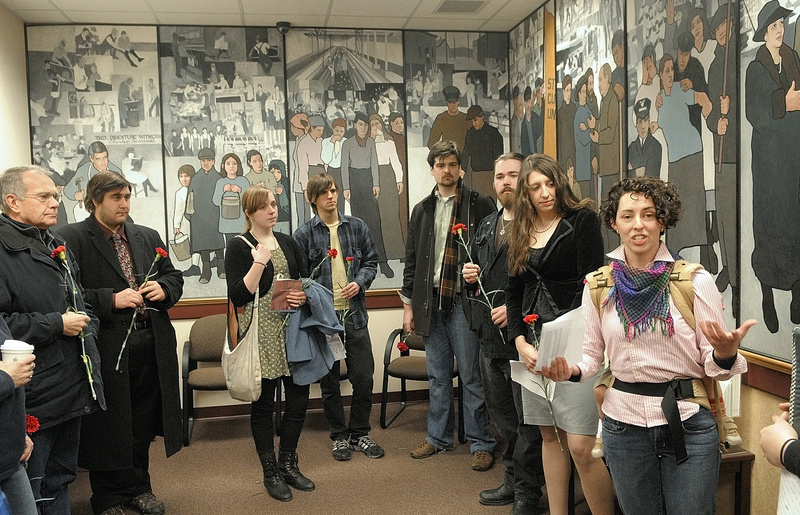BANGOR — Just as Gov. John Baldacci had the right to install a mural in the Maine Department of Labor’s headquarters three years ago, Gov. Paul LePage had the right to remove it last month, Deputy Attorney General Paul Stern said Tuesday in U.S. District Court.
While Stern defended LePage’s right to “government speech,” attorneys for six plaintiffs argued that the U.S. Constitution bars government officials from taking down artwork simply because they don’t like the political viewpoint of the artist.
Attorneys Jeffrey Young and Jonathan Beal are asking Maine’s chief federal judge, John Woodcock, for an order to return the mural to the lobby of the Labor Department’s headquarters in Augusta.
The 11-panel mural depicts scenes from Maine’s labor history, including two strikes, Rosie the Riveter during World War II, loggers, child laborers and textile mill workers. LePage, a Republican, had it removed because he said it presents a one-sided view of the state’s labor history.
Woodcock heard arguments from both sides for nearly two hours Tuesday. It is unclear when he will make a ruling. He said he was reluctant to make a rushed decision about a complex First Amendment issue.
Some of his comments, though, indicated that he may support the LePage administration’s argument that the mural is a political statement. At one point, he speculated that a future Democratic governor will return the mural to the Labor Department’s lobby.
“The ultimate arbitrator of the decision of the governor is the people of Maine,” said Woodcock, who was appointed to his post in 2003 by President George W. Bush.
After the hearing, about 30 protesters demonstrated at a nearby park in support of the mural. One of the event’s organizers, Edgar Allen Beem of Yarmouth said LePage’s actions may be legal, but they still amount to censorship.
“If the governor can legally remove any work of art he doesn’t like from public view, does he also have the power to remove any book from the state library?” Beem asked while addressing the demonstrators. “Based on the state’s argument, we have to assume he does.”
Young told the court that the plaintiffs’ First Amendment rights are being violated. He said they are being denied the ability to view the art, which is in storage somewhere in the Central Maine Commerce Center, the building where the Department of Labor has its headquarters.
“The First Amendment protects the listener or viewer to the same extent it protects the creator or artist,” Young said.
Central to Stern’s argument for the administration was the U.S. Supreme Court’s ruling in 2008 in a case involving Pleasant Grove City, Utah. That case was about whether the city could deny an obscure religion’s request to display a monument in a public park, while the city allowed the display of a monument about the Ten Commandments.
The court ruled unanimously that monuments in public places should be recognized as the government’s own speech, and that decisions about their placement are exempt from the free speech clause of the First Amendment.
After Tuesday’s hearing, Stern said in an interview that the issue is the role of government in a democracy.
“The government, after it is elected, is allowed to speak,” he said. “If people don’t like it, they can wait until an election and vote.”
Young, a civil rights attorney, argued that the mural is different from a monument. When most people see a painting, he told Woodcock, they assume it represents the viewpoint of the artist, not the government.
Moreover, the mural’s artist, Judy Taylor of Tremont, has a contract with the state that requires her to be notified and consulted if the mural is removed, and she retains the mural’s copyright, Young said.
Woodcock said that because Taylor has not joined with the plaintiffs, her contract isn’t relevant to the case.
The six plaintiffs are Beal, a labor lawyer from Portland; Don Berry of Sumner, president of the Maine AFL-CIO and head of the training committee of the International Brotherhood of Electrical Workers Local 567; John Newton of Portland, an industrial hygienist with the federal Occupational Safety and Health Administration; and Robert Shetterly of Brooksville, Natasha Mayers of Whitefield and Joan Braun of Weld, all current or past members of the Union of Maine Visual Artists.
MaineToday Media State House Writer Tom Bell can be contacted at 699-6261 or at: tbell@mainetoday.com
Send questions/comments to the editors.



Comments are no longer available on this story